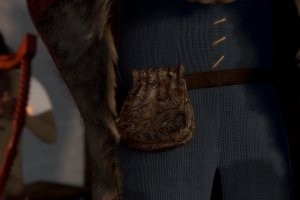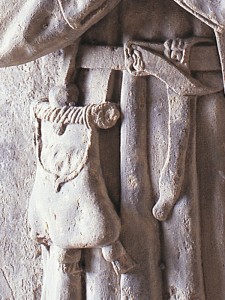
PursesIt was quite essential for a travelling poet to carry a purse which would usually hang from his belt; pwrs and amner are the terms used by poets of the period. All kinds of objects could be hung from belts. Guto’r Glyn mentions wearing a knife, beads and purses on his belt. Other poets talk about attaching the harp to their belt, and it was also common to attach small mirrors and books.
There were all kinds of purses. The most elegant and expensive ones were produced in foreign locations which specialized in embroidery, such as Paris.[1] However, a leather pouch closed with a string was the earliest and simplest type. Gradually, purses came to be decorated with fine materials, and as textiles such as silk and velvet became easier and cheaper to buy, whole pouches could be made of various textiles of all shapes and sizes.
Another type was the purse which had a flap to close it; it was easily attached to the belt because it was possible to close the flap around the belt. Leather was the main material used for these purses, and sometimes this was adorned with decorative stitching. These purses were quite complex to make because of the need for several pieces of leather, and sometimes they would have more than one pocket on the inside. A development specifically associated with the mid-fifteenth century was the use of a metal frame for the purse. Part of the frame was invisible because it was on the inside of the purse, but the part which connected the purse to the belt — a metal handle and strip — would be visible for everyone to see, and would often be very decorative.[2] Purses with metal frames had a slightly larger opening and were therefore more convenient for extracting money from the inside. Purses like these were also used when hunting.[3] As with any piece of clothing, it was possible to decorate purses with all kinds of embroidery and decoration. There are references to silk and velvet purses in the poetry, and it appears that these fine textiles were also used in the two purses Guto’r Glyn received as gifts from his patrons, Catrin daughter of Maredudd of Abertanad (poem 87) and Sir Rhisiart Cyffin (poem 59). Some poets composed whole poems to complain that their purses were empty (for a discussion on this genre, see GSCyf 150). Indeed, when a poet indicates that his purse is full, it is an image to highlight a patron’s generosity; see Guto’s poem to Sir Benet ap Hywel, Llawn fu amner pob clerwr ‘Full was every poet’s purse’ (poem 47.43). Bibliography[1]: S. Farmer, ‘Biffes, Tiretaines, and Aumonières: the Role of Paris in the International Textile Markets of the Thirteenth and Fourteenth Centuries’, Medieval Clothing and Textiles, ed. G. Owen-Crocker (Boydell and Brewer, 2006), 88.[2]: D.A. Hinton, Gold and Gilt, Pots and Pins (Oxford, 2005), 253. [3]: G. Egan & F. Pritchard, Dress Accessories c.1150—c.1450 (London, 1991), 356—7. |
Unless otherwise noted, copyright on the content of this website belongs to the University of Wales







